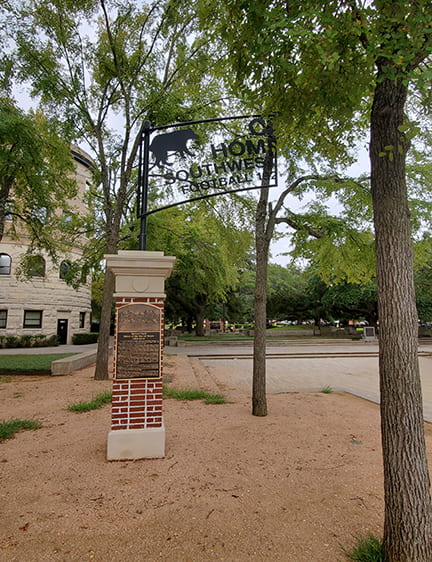This article was written by B.J. Thome, a graduate assistant at The Texas Collection pursuing his PhD in English.
In celebration of National Black Business Month this August, The Texas Collection is spotlighting a few historic Black-owned businesses in Waco and the accomplishments of their owners.
M. Sublett and Son

One of the first Black-owned businesses in Waco was L. M. Sublett and Son Grocery Store. The store operated during the early twentieth century, becoming one of the largest and most successful Black-owned businesses in Waco, on par with any other grocery store in Waco at the time. Sublett’s business focus wasn’t limited to just the grocery store, however; he also owned a couple farms and several houses that he rented out. By 1928, Sublett’s monthly income from his business endeavors was estimated at approximately $2,000.00 per month (roughly $31,000 per month when adjusted for inflation). Sublett’s endeavors weren’t limited merely to the business sphere. He was also politically active. In particular, he fought for voting rights for his fellow Black men and women. In the early twentieth century, one form of voter suppression was restricting primary elections to white voters only. In 1923, Sublett, among others, successfully sought and received an injunction from Judge Irvin Clark to prevent the Democratic party from excluding Black voters from the city’s primary elections.
Mecca Drug Store

Another prominent early twentieth-century Black-owned business was the Mecca Drug Store, located in the Fridia Building in downtown Waco. The drug store was originally opened by Dr. J. Walter Fridia, who first started practicing medicine in Waco in 1898. Shortly thereafter, Dr. Fridia purchased a three-story building on the corner of Bridge and Second Streets, opening the Mecca Drug Store on the first floor and providing space for physician and dental offices on the second floor and space for other business offices on the third floor. Around 1912, E. E. Clemmons, who had earned a pharmaceutical degree from the University of Michigan, came to work for Dr. Fridia as a druggist. In 1921, Clemmons bought the store from Dr. Fridia and continued to operate it for several decades afterwards. Clemmons even weathered the 1953 Tornado which devastated downtown Waco and severely damaged the Fridia Building. Clemmons rebuilt and reopened the store after the storm, continuing to operate it until 1968.


Dr. Garry Radford, Sr./East Side Cab Company

Another prominent Black business owner in mid-twentieth century was Dr. Garry Radford, Sr. In 1944, Dr. Radford moved to Waco and set up his own dental practice in the Conner Building, another Black-owned building in downtown Waco housing several Black-owned businesses and offices. Eventually, his practice expanded to have sixteen employees and gathered enough income to be listed by Dunn & Bradstreet. Like other prominent Black doctors/businessmen, Dr. Raford didn’t restrict himself to just his dental practice. He also invested in other Black-owned businesses, including the East Side Cab Company. The East Side Cab Company was originally organized by Johnnie Boy Holland in 1945. In 1946, Holland, along with J. D. Fikes, bought the Bridge Street Cab Company from Herbert Walker and merged it with the East Side Cab Company. (There were several Black-owned taxi companies in Waco at the time, responding to the demand for taxis that would carry Black passengers since companies like Yellow Cab refused to offer service to non-white customers.) In 1949, Dr. Radford bought half interest in the East Side Cab Company and even purchased several new cars for the company. As a result of the 1953 Tornado, however, the East Side Cab Company’s office and fleet were severely damaged, prompting Radford close down the company and refocus his efforts on community service and politics.
Like Sublett, Radford was actively involved in politics. In fact, in 1966, he decided to run for his district’s seat on the Waco City Council. At first, his chances of winning appeared slim. In fact, the radio announcers initially proclaimed his opponent, Les Tooker, to be the winner of the election. They even went as far as conducting an interview with Tooker, a white man, regarding his plans for his presumed tenure in office. After all, Tooker was ahead by three hundred votes with only a single box of votes remaining to be counted. However, that single remaining box of votes was Box 10C—the box from Radford’s home district where Radford himself went to vote. When the votes from that final box were counted, 455 votes had been cast for Radford and only 2 votes had been cast for Tooker. Despite the radio’s premature announcement of Tooker’s victory, Dr. Radford actually won the election by a margin of only 146 votes, becoming the first Black man elected to a public office in Waco’s history.
Bibliography
Garry Hamilton Radford papers, Accession #2221, Box #1, Folders #2-3, The Texas Collection, Baylor University.
Hall, Ida Legett. History of the Negro in Waco Texas : Sociology 232, Spring 1928. Waco, Texas: Ida Legett Hall, 1928.
Radford, Garry H., Sr. African-American Heritage in Waco Texas: Life Stories of Those Who Believed They Could Overcome Impediments. Austin, Texas: Eakin Press, 2000.
Hunter, Selese. “A Study of Negroes Engaged in the Professions and Business Activities of Waco, Texas.” Waco, Texas: Baylor University, 1927.
Wilton Lanning papers, Accession #4039, Box #9, Folder #26, The Texas Collection, Baylor University.




















